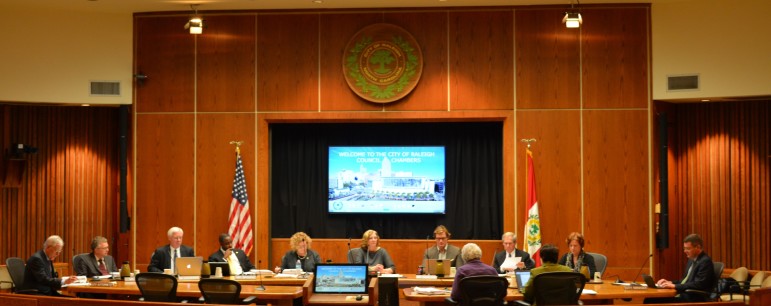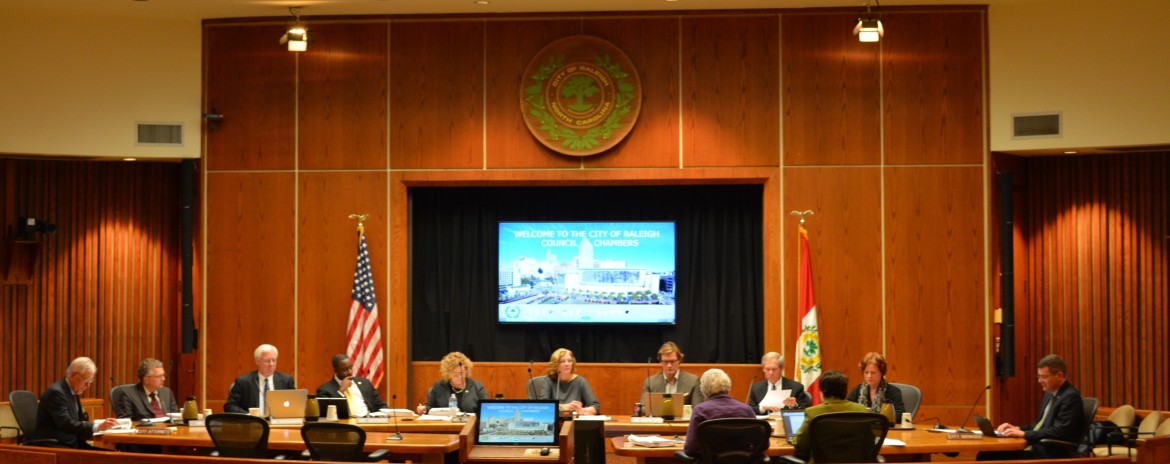The Council Record is an informal but nevertheless comprehensive look at the most recent City Council meeting.

March 1, 2016
As always, the Raleigh City Council meeting last week began with an invocation, led this time by Dr. David C. Forbes of Shaw University’s Divinity School, and the Pledge of Allegiance, led by Councilor Mary Ann Baldwin.
Presentations & Awards
The only presentation heard by Council last week was from Rob Schiller, a senior vice president with the North Carolina Symphony.
Schiller thanked the City for its “long-standing support and a tremendous partnership.” He noted that more than half of their annual performances take place in the Triangle region, many of those at Meymandi Concert Hall. The revenue generated by the symphony, he said, was about $2.75 for every dollar the City had invested.
Mayor McFarlane asked if Schiller could get the Moody Blues to join the symphony in a performance, then said the City was extremely fortunate to have an organization like the North Carolina Symphony call it home.
Consent Agenda
Only one item was pulled from the consent agenda last week, item 7.1. The item dealt with establishing a no-parking zone on the south side of St. Albans Drive, west of the intersection with Cardinal at North Hills Street.
Councilor Bonner Gaylord asked that the issue be held two weeks so he could look into some existing issues in the area to ensure they don’t get worse. Council in January had an extended discussion over the establishment of a two-hour parking zone on Toxey Drive. As there was no comment or discussion other than Counilor Gaylord’s request that it be held, it does not appear this parking request will be as hotly contested.
Report and Recommendation of the Planning Commission
Planning Commissioners only had one case to bring before Council this week, Z-2-16. The case would designate the Glenwood-Brooklyn neighborhood in central Raleigh as a Historic Overlay District. Located off Glenwood Avenue near Fred Fletcher Park, the neighborhood traces its roots back to the early 20th century.
Planning Commission Chairman Steven Schuster noted that there had been an “overwhelmingly amazing amount of support” for the case, although he wanted to note that important questions had been raised regarding the established boundaries of the proposed overlay district.
“We did hear from some property owners, mostly commercial, who wanted the boundaries moved to remove themselves from the district because of their long-term commercial desires.”
Schuster explained that the boundaries had been established by state, national and local guidelines, and that the Planning Commission didn’t feel it had the “authority or the expertise” to change the boundaries and that such a decision was better left to Council.
A public hearing was scheduled for April 5 for the case.
Special Items
The first special item case was Z-41-15, which would rezone a portion of the 3100 block of Hillsborough Street to allow for a five-story neighborhood mixed-use redevelopment. Most of the discussion centered on whether a public hearing would be scheduled for March 15 or April 5.
By holding it to April 5, when the hearing would be conducted during an evening session, more members of the public would be able to voice any concerns they might have. Councilor Russ Stephenson noted that the applicant had gone out of their way to work with existing property owners, but that the local Citizens Advisory Councils had voted against the rezoning nonetheless.
Next up was the Dangerous Dog Ordinance, an issue that’s come before Council several times this year. Councilors have submitted a number of questions and clarifications since the initial presentation, and those have all been taken into account for the final version presented at the March 1 meeting.
The only request Council had came from Cory Branch, who requested that a list contained in the report of behavior and training options be made available in the event anyone had questions.
This was agreed to, and the ordinance was unanimously approved. It will become effective March 15.
The ordinance contains the following provisions:
- Clarify and expand the definition of “dangerous dog”;
- Eliminate the need to declare a dog “potentially dangerous” by expanding the definition of “dangerous dog”;
- Define “provocation” and “serious injury”;
- Establish clear restrictions for keeping a dog that has been declared dangerous;
- Establish what actions Animal Control can take when a dog that has been declared dangerous is found at large or inflicts serious injury on a person or domestic animal;
- Establish an appeal process when a dog has been declared dangerous or when a determination has been made that a dog should be destroyed;
- Authorize summary destruction of an animal that has been determined to be dangerous and who cannot be seized, humanely trapped or tranquilized if destruction is necessary for the protection of life or property or for public health and safety; and
- Require notification to the Animal Control division when an animal bites a person, unless the person has provoked the animal
Reports of Mayor and Council Members
The relatively short afternoon session held March 1 was nearly wrapped up in less than 30 minutes, and the final public portion of the meeting involved reports from two of the Councilors.
Councilor Branch requested that $50,000 from the Council’s contingency fund be appropriated to Advance Community Health, which recently opened a new facility on Rock Quarry Road. The facility can accommodate 10,000 patients, and is the new home of the Rex Senior Health Care Facility.
It was suggested that the money be taken out of the City’s grant fund, rather than the Council Contingency Fund. On this condition, Branch’s request was approved unanimously.
Councilor Baldwin also had a request for funds from the contingency fund, a request that was also granted unanimously. Baldwin asked that the City spend $2,500 to help sponsor the Wake Up Wake County Downtown Walkability tour, which will be held April 16 and which has been supported by the City for several years.
Council then adjourned into an hour long closed-session wherein they discussed the “Cook Vs. The City of Raleigh” lawsuit, another potential lawsuit, and some attorney-client matters.
Following the closed session, Council was adjourned until their 7 p.m. evening session.
Evening Session
The Council’s evening session lasted about as long as the public portion of its afternoon session — about 35 minutes. The only item on the agenda was several citizen petitions.
Requests and Petitions of Citizens
- The first petition was from Susan Flanagan from the Raleigh Tennis Association, who said they would like the City to build more tennis courts. She said they would return to Council at another time with a fuller presentation.
- Next up was Coby Crandall from Pro Se Re-entry Incarceration Services. His organization works to help recently released inmates re-adapt to society. He said while there were plenty of services available to these individuals, that having an advocate to help guide them through the various processes would do them a lot of good. In addition, he said the re-entry process should start not when the convicts are first released from prison, but when they are first brought into the criminal justice system.
- Scott Bendrube was on hand to discuss with Council a wide number of issues and problems that had befallen him and his property following the Leesville Road Widening project. While he had already received some compensation from the City for right of way and other issues, the shoddy work done by Devere Construction, the low bidder hired by the City, had resulted in a number of problems he wanted the City to compensate him for. Staff said they were working with the bonding company that had worked with Devere on the project, and said they would have a report for Council in two weeks. Bendrube was told he would be contacted sooner. “We like you,” joked McFarlane to Bendrube, “But we don’t want to have to see you back here.”
- The final citizen to speak that night was David Simonton, who said that he and other residents had been misled when they signed the Lorimer Road Street Improvement petition. They were told that the proposal of a 27-foot wide street, a 6-foot sidewalk and a 7-foot right of way were not set in stone, and that they would likely be reduced. Simonton said his house had been built in 1950 and their street in currently 19 feet wide; his quiet West Raleigh neighborhood, he argued, did not need to updated to current design standards. He asked Council to consider reducing some of the setback requirements that resulted from the petition.
